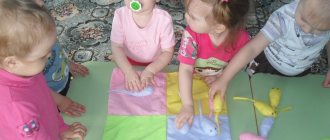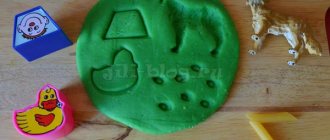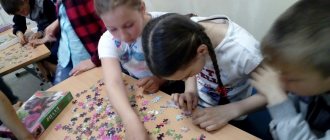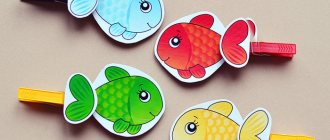Children's button piecing templates are sheets of illustrations containing blank spaces, usually in a circular shape. It is this kind of pass that the child is asked to close with a button.
In fact, button lining templates can also be successfully used with pompoms, round stickers, plasticine patches, finger painting, etc.
Fine motor skills involve using the small muscles of the hand. Exercising and strengthening these muscles allows children to improve functions such as holding small objects, buttoning clothes, and coloring, and eventually writing .
Buttons and pompoms are items that most of us have around the house. We use these colorful parts to make crafts together with the children and carry out minor household repairs. You can also use these simple objects to develop your child's fine motor skills .
Print templates for button lining
In addition to effective fine motor development, practicing with button patterns improves attention, sensory abilities, perseverance and concentration, ability to distinguish and select colors , etc.
Additional Templates
The site has many templates with round gaps for finger painting, filling with plasticine, gluing round stickers, etc. “Circles” can also be stamped with bottle caps, a cut-out stamp made from potatoes, sponges, eva, etc.
Of course, all these templates are similar and interchangeable. You can download finger painting templates and fill it with buttons and vice versa.
Where can I download additional patterns for laying out buttons ? Here:
- Templates for finger painting,
- Plasticine patches.
Didactic material on the development of fine motor skills of the hands
Porkhunova Anna Yurievna
Didactic material on the development of fine motor skills of the hands
Explanatory note.
Fine motor skills - the ability to manipulate small objects, transfer objects from hand to hand, and perform tasks that require coordinated use of the eyes and hands.
Fine motor skills are the coordinated actions of the nervous, muscular, and skeletal systems, often in conjunction with the visual system to make small, precise movements of the hands, fingers, and toes.
From early childhood, fine motor skills are the most powerful tool for the process of functional maturation of the brain, as it is a powerful tonic factor for the cerebral cortex and tactile perception of the child. All mental processes of consciousness, both conscious and unconscious, are reflected in small movements of the fingers, hand position and gestures. The fact is that in the human brain the centers responsible for speech and finger movements are located very close. The development of the functions of both hands and associated with the formation of speech centers in both hemispheres gives a person advantages in intellectual development, since speech is closely connected with thinking.
By performing various exercises with his fingers, the child achieves good development of fine motor skills of the hands, which not only has a beneficial effect on the development of speech (this is how excitation occurs inductively in the speech centers), but also prepares the child for drawing and writing. The hands acquire good mobility and flexibility, and stiffness of movements disappears, which will facilitate the acquisition of writing skills in the future. Occasional activities cannot produce a positive effect. To achieve the desired result, it became necessary to do regular work on developing fine motor skills and coordination of finger movements. Typically, a child who has a high level of development of fine motor skills can reason logically, has sufficiently developed memory and attention, and coherent speech.
In addition, it has been proven that both the child’s thought and eye move at the same speed as the hand. The close relationship between hand movements and the development of human vision in childhood persists for a very long time. Ask, for example, a preschooler who knows how to count to ten to count several identical objects with his eyes - and you will be convinced that he will not be able to do this without the help of his hands. While counting, he will certainly point his finger at each item. The hand seems to convey its movements to vision. The more complex and coordinated the movements of the hand and eye, the more successfully the child’s visual abilities develop. It is precisely this consistency or coordination of the child’s visual-motor system that is actively formed in drawing, especially at the pre-visual stage (up to 9-10 years).
Exercises.
"Dexterous Pencil"
- a number of exercises are performed: - smoothly rotate the pencil with the thumbs and index fingers of the right and left hands; - move the pencil with all fingers of both hands; - rotating the pencil with your palms, - pinching the pencil with two fingers of both hands (thumb and index; index and middle); - rolling a pencil between the fingers from the thumb to the little finger and back.
Drawing.
In the process of drawing, children not only develop general ideas and creativity, deepen their emotional relationship to reality, but also form elementary graphic skills that are so necessary for the development of manual dexterity and mastering writing. By drawing, children learn to properly handle graphic material and master various visual techniques; they develop fine muscles of the hand. You can draw with black and colored pencils, felt-tip pen, chalk, watercolors, and gouache. Of course, drawing helps develop the small muscles of the hand and strengthens it. But we must remember that when learning to draw and write, the positions of the hand, pencil, notebook (sheet of paper), and methods of drawing lines are specific. Equipment: Paints, pencils, wax crayons or pastels, felt-tip pens and other materials. Drawing paper should be of different formats and shades. It is also necessary to have brushes of different sizes, sponges for painting large spaces, etc. A good place to start is: 1. outlining flat shapes. You can trace anything: the bottom of a glass, an inverted saucer, your own palm, a flat toy, etc. Muffin tins are especially suitable for this purpose;2. drawing by reference points;3. finishing the second half of the drawing;4. drawing according to the sample, without taking your hands off the paper. 5. performing hatching. It develops motor dexterity well by drawing ornaments on checkered sheets (graphic exercises), first with a simple pencil, then with colored pencils. You can perform such exercises from 5 to 6 years old. Children engage in this kind of drawing with interest. When the child’s hand gets a little stronger, the drawings he makes become neater and more beautiful.
Working with paper and scissors.
Making paper crafts is also one of the means of developing fine muscles of the hands. This work captivates preschoolers and promotes the development of imagination and constructive thinking. Working with paper ends with a certain result, but in order to achieve it, you need to master the necessary skills, show will, and patience. It is important that children experience the joy of independently completed work and feel faith in their strengths and capabilities.
The artistic technique is origami (paper folding).
Children really enjoy making crafts by folding paper in different ways. Paper is the most affordable and easiest to process material. Children get acquainted with different basic forms of origami and use them to make crafts by bending and folding paper multiple times. Parents are encouraged to try simple crafts using the origami technique at home with their children. The child can use these crafts in his games and theatrical activities. The craft can be an excellent gift or souvenir. Paper folding promotes the development of fine motor skills of the hand, develops spatial imagination, eye perception, activates thought processes, relieves stress, and develops perseverance.
Drawing with plasticine.
This type of productive activity belongs to non-traditional drawing techniques. Children are offered plasticine of different colors and a schematic drawing on thick paper or cardboard. Children smear the plasticine with their fingers without going beyond the contours of the drawing. At the same time, they have to apply a certain force to smear the plasticine. This is a good exercise for developing fine movements of a child's hand. Plasticine must be prepared in advance, i.e. soft. Plasticine drawings turn out unusual and beautiful. This type of activity is available for activities with children at home.
Quilling (paper rolling).
This type of artistic technique is very interesting. The crafts turn out to be unusual and beautiful. Quilling is good for activating small movements of a child’s hand when winding strips of paper onto a toothpick or small stick. Crafts using this technique can be used as souvenirs, and the details can be used to decorate postcards, albums, boxes, photo frames, etc. Parents and their children can make an interesting craft using the quilling technique to decorate the interior of the house.
Game "Travel of Fingers".
Goal: development and training of coordination of finger movements, development of fingertips, development of attention. Material: a sheet of paper depicting 2 houses at different ends of the “islands” for moving fingers. Progress of the game: the child places his fingers near the first house. Then he begins to move his fingers along the islands to another house, without taking his fingers off the other “bump.” Rules: 1. you can move, for starters, using 2 fingers; 2.all fingers must be involved; 3.You cannot tear off the first finger without moving the other one.
Exercise "Chair"
Goal: development of dynamic coordination, alternation of movements. Instructions: left palm vertically up. A fist is attracted to its lower part (with the thumb towards you). If the child easily performs this exercise, you can change the position of the hands alternately for a count of times.
Exercise "Table"
Goal: development of dynamic coordination, alternation of movements, development of switchability. Instructions: left hand in a fist. The palm is placed on top of the fist. If the child easily performs this exercise, you can change the position of the hands: the right hand in the fist, the left palm on top of the fist. You can do it alternately at the count of times.
Exercise "Drummer"
Goal: developing the skill of voluntary movements with the abandonment of motor stereotypes. Instructions: beating one beat at a time with your right (left) hand, simultaneously with the beat, beat with your right hand, hit the table with the index finger of your left hand.
Exercise “Advanced Drummer”
Goal: developing the skill of voluntary movements with the abandonment of motor stereotypes, holding a pose. Instructions: put your right (left) hand in front of you with your fingers apart, place the index finger on the ring finger or the middle finger on the index finger (or vice versa) and lightly tap the tempo.
Subject finger exercises
“Fingers greet” - the fingertips touch the thumb (of the right, left hand, two at the same time).
“A flower is blooming” - fingers “appear” one after another from a clenched fist.
“Rake” - palms facing yourself, fingers intertwined.
Finger exercises combined with sound gymnastics
The child can alternately connect the fingers of each hand to each other, or straighten each finger in turn, or clench his fingers into a fist and unclench and at this time pronounce the sounds: “Tongue song” - La - la - lalala, lololo - lo - lo - lo ..... Pa - pa, mom, grandma, grandpa...
Finger kinesiological exercises / “brain gymnastics” /
Proposed by I. Dennison and his wife G. Dennison. With the help of such exercises, the work of the left hemisphere is compensated. Their implementation requires attention and concentration from the child.
“Ring"
- alternately move your fingers, connecting them into a ring with the thumb, sequentially index, middle, etc.
“Ear - nose"
Take the tip of your nose with your left hand, and the opposite ear with your right hand, then simultaneously lower your hands and change their position.
“Symmetrical drawings”
- draw mirror-symmetrical designs in the air with both hands / it is better to start with a round object: apple, watermelon, etc. The main thing is that the child looks at his hand while “drawing”.
“Horizontal figure eight"
draw the number eight in the air in a horizontal plane three times - first with one hand, then with both hands.
Finger exercises combined with self-massage of the hands and fingers
These exercises use traditional massage movements - kneading, rubbing, pressing, pinching / from the periphery to the center /.
“Let’s wash our hands under hot running water.”
- movement, as when washing hands.
“We put on gloves”
— with the thumb and forefinger of the right hand, rub each finger of the left hand, starting with the little finger, from top to bottom. Finally, rub your palm.
“Pickling cabbage"
- movements of the edge of the palm of the right hand against the palm of the left hand: tapping, sawing. Movements of both hands: imitation of sprinkling salt, clenching your fingers into a fist.
“Let's warm our hands"
- movements as when rubbing hands.
“Hammer"
- use the phalanges of the fingers of the right hand clenched into a fist to “hammer nails.”
“Geese are nibbling grass"
— the fingers of the right hand pinch the hand of the left.
Theater in hand
Allows you to increase overall tone, develop attention and memory, relieve psycho-emotional stress.
"Butterfly."
- clench your fingers into a fist and alternately straighten the little finger, ring and middle fingers, and connect the thumb and index into a ring. Make quick movements with straightened fingers / “finger fluttering” /.
"Octopuses."
- the right hand, carefully and one by one moving its tentacles - fingers, travels along the seabed. An octopus is moving towards him - his left hand. We saw each other. They froze, and then began to explore the seabed together.
"Bunnies."
Goal: to develop movements of the hands and fingers, the ability to act by imitation; arouse interest and a positive emotional attitude towards the game. Progress of the game. The teacher folds his fingers, getting an image of a bunny on the screen: the little finger and ring finger are bent and held with the thumb - “muzzle”, and the other two fingers rise up - “ears”, the hand bends slightly forward. A bunny jumps on the screen. “This is a mother hare looking for her hares. Where are they?" - says the teacher and invites the children to make bunnies. He helps each child fold their fingers correctly. After this, the children raise their hands, bringing them closer to the screen, and the bunnies jump around the hare. The teacher encourages children's emotional displays.
«Geese."
Goal: Continue to develop attention and imitation when moving the hands and fingers; learn to perform movements with both hands at the same time; arouse interest in the game. Progress of the game. The teacher says that today it will not be bunnies, but geese, who will come to visit the children. He squeezes all four fingers together, and presses the thumb against them from below, sharply bending the hand down (Fig. on p. 36). “Ha-ha-ha, where are my goslings?” - he says and helps the children make goslings with one hand. The goslings are walking with their mother, she calls them: “Geese, geese!” The children answer: “Ga-ga-ha.” - “Do you want to eat?” - continues the teacher. The children answer: “Yes, yes, yes.” In the future, the game can be complicated. Each child takes two goslings for a walk, that is, he makes gosling figures with two hands. Geese can follow their mother closely.
Exercise “Braid a pigtail”
- braid three cords (single or multi-colored) into a braid.
Exercise "Paper"
- crumple, straighten, twist, unwind, fold, try to work with your fingers (fold a fan, hat, steamer).
Exercise “Special drawing”
- by points, along a contour, according to a stencil (simple, complex), according to a sample, verbal instructions.
Exercise "Color"
- coloring books, drawn by an adult or a child.
Exercise "Hatching"
- use longitudinal, transverse, diagonal, diagonal-transverse lines to shade the drawn geometric shapes, vegetables, fruits, etc.
Exercise “Rubber toy”
- squeeze and unclench a rubber toy.
Exercise "Beads"
- string beads, buttons, etc. onto a thread. different sizes, colors.
Exercise "Moth"
- squeeze the pear, squeeze the spray gun, direct the air stream at the cotton wool, at different distances and different strengths.
Exercise “Wonderful bag”
- small toys, geometric shapes, dummies of vegetables, fruits, outlines of letters - the child feels with his hand, names the object, then takes it out of the bag, clarifies the name.
Exercise "Pinch"
- squeeze your fingers into a pinch - spread them apart.
Exercise "Mosaic"
- (small and large) lay out patterns, objects, figures, letters, etc. according to the pattern.
Exercise "Sculpting"
- knead, roll plasticine, wax, clay between your palms on the table, then make an object.
Exercise “ Button and Unfasten”
- fastening and unfastening buttons (on a leg, of different sizes).
Exercise "Threads"
- wind the threads from one ball to another, from one tube to another (threads of different colors and thicknesses).
Exercises with test:
1. Pinch off pieces with two fingers, then stick them on (for example, eyes). 2. Clap the dough, flatten it with your whole palm, roll sausages with your palm and each of your fingers. 3. Imprint fingers and chopsticks on the dough. 4. Combine the dough with other materials (peas, beans, twigs, vermicelli, straws) 5. You can make rings and string them on a string.
To develop the hands and fingers, it is useful to play games with cereals, such as rice, buckwheat, beans, semolina, and peas. Cereals can be poured from one plate to another, poured through a funnel. You can also mix several grains together, such as rice, buckwheat and peas. You should prepare 3 plates: put rice in one, buckwheat in another, and peas in the third. The game develops children's thinking and gives a hand massage.
Clothespins
Another great finger exerciser is clothespins. Show the children how they can be attached to any flat object, for example, cardboard, a wide ruler, or a plate. Over time, the task can be complicated: ask your child to fasten the clothespins to a stretched rope. To make your classes more fun, make special cardboard blanks, for example, you can cut out the silhouettes of a hedgehog and the sun. It will be much more interesting for the child to catch needles from clothespins to the hedgehog, and rays to the sun.
Lacing
By the age of 1-1.5 years, children are very interested in all sorts of holes, strings, and laces. Lacing was invented for this age. Maria Montessori gave her children pieces of leather with holes and laces almost a hundred years ago. Nowadays you can simply buy a “lacing game” - a set of multi-colored laces and a shoe, button, “piece of cheese” or something else. Games - Maria Montessori's lacing: - develop sensorimotor coordination, fine motor skills of the hands; - develop spatial orientation, promote understanding of the concepts “above”, “below”, “right”, “left”; - develop lacing skills (lacing, tying a lace into a bow); - promote speech development; - develop creative abilities.
“Paths”
Draw straight lines down the middle of the path without lifting the pencil from the sheet of paper or moving off the path.
“Paths”
Draw lines along the middle of the path without lifting the pencil from the sheet of paper or moving off the path.
Exercises for developing fine motor skills of the fingers “Ship”
Guide your ship (by the shortest route) to the port so that it does not run aground.
Help the little mouse find his mother. Note: it is important that the child, when tracing the path from the mouse to his mother, draws a line in the middle of the tunnel, without touching its walls.
Exercise “Routes”
Target:
development of fine motor skills.
Material:
printed form of the methodology, a simple pencil.
Instructions:
The child is given a printed form of the technique and asked to draw a path along each route with a pencil, trying not to touch the “walls”.
Exercise “Sample by cell”
Exercise “Color the shapes”
Assignment: color all the circles red, squares blue.
Exercise “Copy the sample by points”
Target:
development of the child’s ability to act according to a model.
Material:
printed methods forms.
Instructions:
It is necessary to copy point by point the drawing (or pattern) placed as a sample in the upper left corner of the sheet.
TASK 1 The child must trace the figures along the dotted lines with a simple pencil and color these figures with colored pencils.
TASK 2 Color the drawing with colored pencils.
TASK 3 Trace the drawing along the contour and finish drawing it so that it looks like the drawing on the left, then shade it in one direction.
TASK 4 Trace the patterns in the cells along the dotted lines and continue the row to the end.
Circle stickers
Once the patterns for laying out buttons are mastered, you can move on to a slightly more complex step - gluing round stickers. This doesn't mean buttons should be a thing of the past! A familiar and understandable activity gives children a pleasant feeling, a “situation of success.” Further activities should not be associated with torture and tears “I couldn’t!”, but with joy: “ I did it !”
Babies over 1 year old are very interested in stickers. And they are quite capable of gluing round reusable stickers! The Dragonfly publishing house has a whole series of brochures with round stickers that have become real bestsellers!
A series of books “Reusable stickers Circles” on the Labyrinth, on Myshop. Here are examples of spreads from these manuals:
Round stickers, like templates for laying out buttons, will improve fine motor skills of the fingers, help you get acquainted with the world around you, and develop imagination and intelligence. Give your child freedom of action , and he will be able to cope with them by completing tasks in a playful way. You just need to control him sometimes and don’t skimp on praise.
Here are examples from another, similar series of tutorials, “Circle Stickers,” also from Dragonfly.
Round stickers from Iskatel and Prof-Press are also good, but they are not as loved by kids as those suggested above.
What does it mean to develop fine motor skills?
Fine motor skills are the ability to reproduce precise movements with the hand and fingers. This is important not only for developing beautiful handwriting, we must also remember that the phalanges of the fingers are the main tools in the work of representatives of many professions. The development of fine motor skills in children aged 6-7 years is facilitated by drawing, playing musical instruments, working with plasticine and small construction sets. But the greatest effect is obtained as a result of special classes.
The exercises offered to children help develop accuracy and speed of movement. As a result of their implementation, the hands and fingers will become stronger, flexible and mobile. There are three types of such tasks:
- exercises with small objects;
- graphic tasks;
- finger games.
In light of preparing for school, the greatest attention should be paid to completing graphic tasks. Children must learn to hatch and draw lines of different thicknesses and shapes. At the same time, it is necessary to ensure that they draw lines without lifting the pen from the paper, do not go beyond the designated contours, do not leave spaces, perform movements correctly (from top to bottom, left to right), do not turn the notebook, and sit correctly at the table.
Classes to develop fine motor skills of the hands should be carried out regularly, studying for 10 - 20 minutes a day. Monotony and monotony should not be allowed; during the lesson, children should be offered several different exercises with exciting game content. To do this, the teacher and parents are invited to use a card file of exercises for the development of fine motor skills in children 6 - 7 years old.






